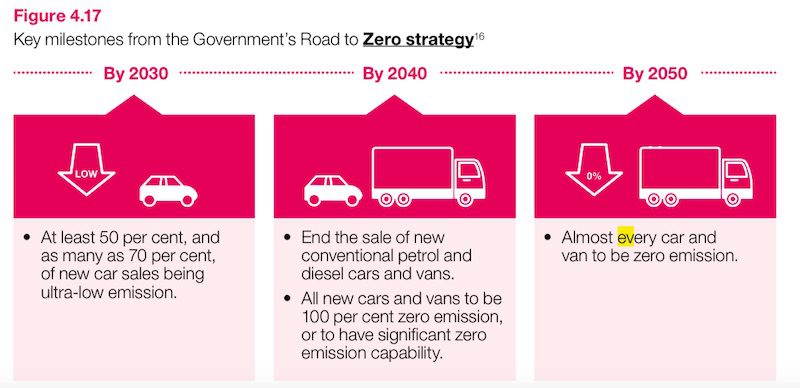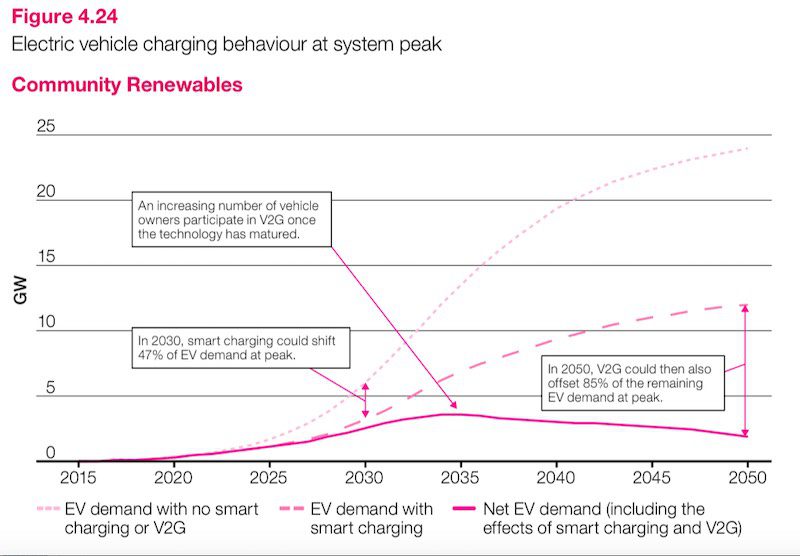Electric vehicles will be vital to decarbonising Great Britain and will play a critical role in providing greater flexibility for the grid and supporting increased production from renewable energy sources, according to a new report from National Grid.
The analysis predicts there will be up to 36 million electric vehicles on the road by 2050 – virtually every vehicle will be electric – and National Grid sees the potential to use EVs to store roughly one fifth of GB’s solar generation for when this energy is needed.
“Electric vehicles can help decarbonise both transport and electricity supply for Great Britain,” it says in its Future Energy Scenarios report released late last week. “The market needs to align vehicle charging behaviour to complement renewable generation and meet system needs.”
 Fortunately, National Grid says that its new studies shows that the timing, location, and frequency of EV charging varies more than previously thought. “This variability has positive implications for the operation of the electricity system,” it says.
Fortunately, National Grid says that its new studies shows that the timing, location, and frequency of EV charging varies more than previously thought. “This variability has positive implications for the operation of the electricity system,” it says.
It suggests that 75 per cent of EVs could be using “smart charging” by 2050.
This will result in a “smart flexible system” – with some 2.8 trillion accumulated data points – that will need new business models and services to match system needs with vehicle charging requirements and consumer preferences.
“The investment in infrastructure to support increasing numbers of EVs indirectly benefits all energy consumers through lower prices and lower carbon generation intensity.”
While studies in Australia have fretted about the “charging” of EVs, and ensuring that it doesn’t happen at the same time and overload the grid, few (apart from Bloomberg NEF) have looked at the potential of using EVs as a storage and flexibility solution.
That is what makes the National Grid report so interesting.
 The overall report lays out five “credible pathways and scenarios” which look out towards 2050 – broadly similar to the Future Grid report produced by the CSIRO and energy networks in 2017, and to the shorter-term outlook of the Australian Energy Market Operator’s Integrated System Plan.
The overall report lays out five “credible pathways and scenarios” which look out towards 2050 – broadly similar to the Future Grid report produced by the CSIRO and energy networks in 2017, and to the shorter-term outlook of the Australian Energy Market Operator’s Integrated System Plan.
Two of the core scenarios – the Two Degrees and Community Renewables scenarios – will see Great Britain meet its original target of reducing emissions by 80% by 2050.
There are also two scenarios which portray a more business-as-usual projection and which would not see the country reach the 80% emissions reduction.
The report also includes an additional scenario which projects a net zero by 2050 picture, and which states that “reaching net zero carbon emissions by 2050 is achievable,” but will require “immediate action across all key technologies and policy areas.”
By 2050, National Grid sees a maximum potential of 36 million electric vehicles, or 99% of all vehicles on the roads.
 In The Community Renewables and Two Degrees scenarios, most road transport is powered by electricity
In The Community Renewables and Two Degrees scenarios, most road transport is powered by electricity
by 2050. Heavy-duty vehicles (high mileage, heavy loads) begin to use hydrogen as fuel from the mid-2030s, especially in Two Degrees.
In Steady Progression and Consumer Evolution, electricity usage for road transport increases, however petroleum-based products are still used out to 2050. Heavy-duty vehicles will continue to use a gaseous fuel, most likely natural gas. Hydrogen remains a niche fuel.
Figure 4.24 highlights the impact of smart charging. Without it, EV demand from the grid could rise to a maximum demand level of 24GW.
But with smart charging, by 2030 smart charging has shifted half of the EV demand away from the peak. And then, with the uptake of more vehicle to grid (V2G) from around 2035, maximum demand from EVs is capped at below 4GW, with V2G ultimately offsetting 85% of the remaining EV demand at peak.
Is it time for AEMO to come up with a similar scenario?

